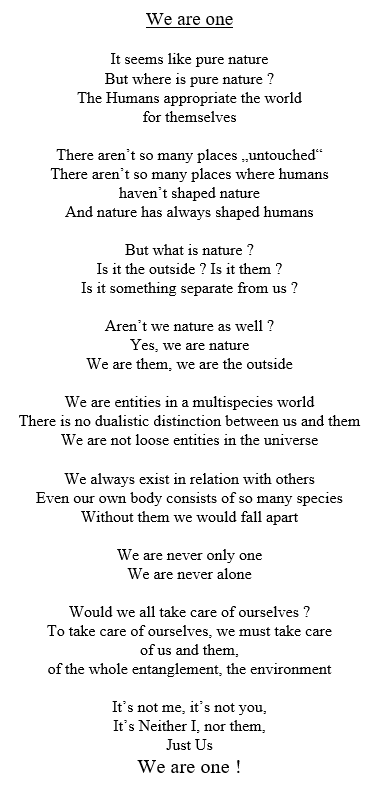Poem, Photography, and Film
Producers of Emotional Knowledge and Creators of Caring and Responsibility about Environmental Issues
12.08.2020
By Helena Held
Supervisor: Dr. Gesa Lüdecke

In recent decades, researchers have often looked for “alternative" ways to conduct and present their research. In anthropology and the environmental humanities, artistic practices have been used as mediums for conveying knowledge, and have been rated as equally effective in increasing knowledge. In anthropology, subjective responses are also used as part of the research, which is rarely if ever purely objective. In addition, auto-ethnographic work, which regards the researchers' own experiences as the basis for the research results, is another possible method for increasing knowledge. Creative experimentation in an academic context is an everyday part of experimental transdisciplinary collaboration.

I, therefore, decided to artistically reproduce my own experiences of “nature” and the connection between the human and nonhuman during my semester abroad in Norway, and in particular in Oslo. The artistic forms I used were poems, photographs, and an experimental short film. My aim was to use my sensory knowledge, conveyed through artistic forms, to trigger an emotional reaction in the audience in order to create a feeling of closeness to the “environment” and “nature,” thus evoking feelings of emotional responsibility grounded in the principle of caring for the future. Experimentation with different mediums and theoretical approaches is important to transdisciplinary fields like the environmental humanities in order to identify new approaches to academic work.
The forests, mountains, and shifting weather conditions made the greatest impression on me and therefore form a big part of my project. Every day I went for long walks or hikes that aroused peculiar feelings and thoughts in me, which gave me a different physical experience and understanding of “nature,” of which humans are indeed apart. I understood myself as a small part of a large cosmos.

Because I wanted to use my sensory perceptions of the Norwegian atmosphere, as well as my embodied and emotional knowledge of Norway's environment, to create a real tangible closeness for the audience, I chose artistic forms. Artistic practices are a method of making us sensitive to physical empathy. In this way, art forms expose human experience that is often lost in texts. I see artistic forms of expression as a potential opportunity to understand situations, other entities, and living beings sensually and on an emotional level. Such a turn to art is becoming more and more important for the environmental humanities. In addition, artistic forms are accessible to a broader audience than are academic texts, including people from outside the Academy, thereby potentially overcoming educational differences as well as disciplinary boundaries.

The goal was to create in the audience a long-lasting feeling of care and responsibility for the environment. Here it is important to perceive oneself in a relational network with animals, plants, and the environment, and thus to recognize the well-being of others as well as of one's own self. Proximity to and empathy for the natural environment can cause positive changes in how we relate to environmental issues. Being able to take care of others, including their emotions and feelings, is important to academic contexts because it leads to a feeling of "connectedness" and thus to (political) action in response to centuries of exploitation and oppression of "nature" and discriminated groups of people.

See the link below for photographs and a poem published in a Norwegian newspaper at the Universitetet i Oslo: https://samfunnsvitern.com/we-are-one/

